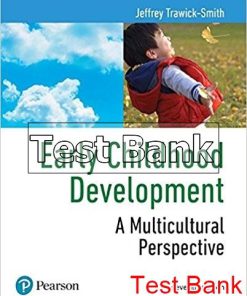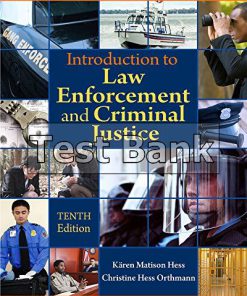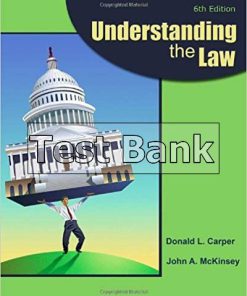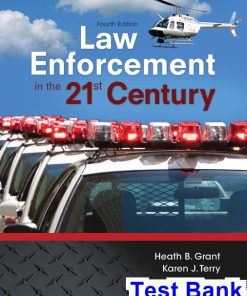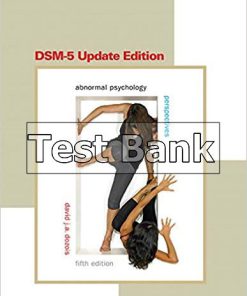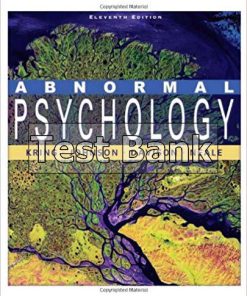Multicultural Law Enforcement 6th Edition Shusta Test Bank
$50.00 Original price was: $50.00.$26.50Current price is: $26.50.
Multicultural Law Enforcement 6th Edition Shusta Test Bank.
Multicultural Law Enforcement 6th Edition Shusta Test Bank
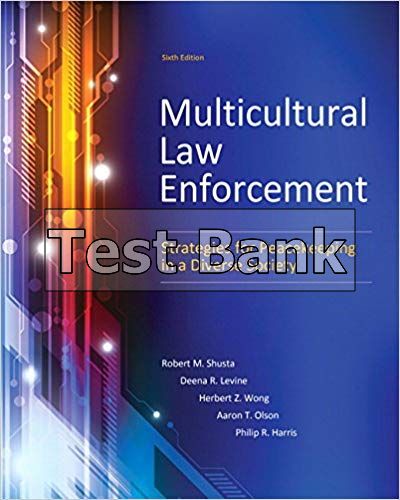
Product details:
- ISBN-10 : 0133483304
- ISBN-13 : 978-0133483307
- Author: Shusta M.P.A., Robert M.; Levine M.A., Deena R.
Multicultural Law Enforcement: Strategies for Peacekeeping in a Diverse Society, 6e is designed for use in criminal justice and social/behavioral science courses, as well as law enforcement in-service training classes and police academies. The textbook is also directly applicable in colleges, university and vocational programs offering emergency services for: police, fire and rescue, emergency medical, emergency management, 911, military as well as civil emergency services.
This comprehensive, student-friendly text, like no other on the market, is designed for students who will become part of a diverse workforce and who, in their future careers, will encounter citizens from many backgrounds.
Table contents:
- Part One Impact of Cultural Diversity on Law Enforcement
- Chapter 1 Multicultural Communities Challenges for Law Enforcement
- Learning Objectives
- Outline
- Introduction
- The Interface of Diversity and Law Enforcement
- The Melting Pot Myth and the Mosaic
- Reactions to Multiculturalism: Past and Present
- Changing Population
- Minority Populations
- Immigrants and Refugees
- Unauthorized Immigrants and Related Terminology
- Further Distinctions between Immigrants and Refugees
- Anti-Immigrant Sentiment
- Community Policing Outreach to Immigrants and Refugees
- Typology of Immigrants and Refugees
- Typology of Immigrant, Refugee, and Minority Individuals
- European Americans
- Unauthorized Immigrants: Demographic Information
- Unauthorized Immigrants: Background Information
- Unauthorized Immigrants: Fear of Deportation
- Unauthorized Immigrants: The “U” Visa and the Safe Reporting of Crimes
- Immigrant Women: Victims of Domestic Violence
- Immigrant Barriers to Positive Relationships with Police
- Culture and its Relevance to Law Enforcement
- The Definition of Culture
- Mini Case Studies and Cultural Practices: Does Culture Matter?
- 1. Culture Matters? The Sword in a Public Park
- 2. Culture Matters? The Turban and the Kirpan
- 3. Culture Matters? A Tragic Case of Cross-Cultural Misinterpretation
- 4. Culture Matters? Latino Values as a Factor in Sentencing
- Dimensions of Diversity
- Primary Dimensions of Diversity
- Secondary Dimensions of Diversity
- Further Diversity within and among Ethnic Groups in the United States
- Prejudice in Law Enforcement*
- Prejudice and Bias
- How Prejudice Influences People
- Peer Relationships and Prejudice
- Summary
- Discussion Questions and Issues
- References
- Chapter 2 The Changing Law Enforcement Agency A Microcosm of Society
- Learning Objectives
- Outline
- Introduction
- Changing Workforce
- Law Enforcement Diversity: A Microcosm of Society
- Racism Within the Law Enforcement Workforce
- Defusing Racially and Culturally Rooted Conflicts
- Conflict Resolution Tips
- Departmental General Order for Control of Prejudicial Conduct
- Police Fraternal Organizations
- Assignments Based on Diversity
- Women in Law Enforcement
- Women in the Workforce
- Number of Women in Law Enforcement
- Workplace Issues
- Sexual Harassment
- Gender Discrimination
- Role Barriers
- The Brotherhood
- A Double Standard
- Differential Treatment
- Career versus Family
- Mentor and Informal Networking Programs for Women
- The Transition of Women into Law Enforcement
- Sexual Orientation in Law Enforcement
- Policy versus Practice
- Recruitment
- The Controversy
- Differences in Treatment of Gay versus Lesbian Officers
- The Transition of LGBT Individuals into Law Enforcement
- Policies against Discrimination and Harassment
- Statutes and Company Policy Pertaining to Discrimination Based on Sexual Orientation
- Training on Gay, Lesbian, and Transgender Issues
- Domestic Violence in LGBT Relationships
- Gender-Neutral Terminology
- Transgender Policies, Protocol, and Training
- Mini Case Study: How Should This Situation Have Been Handled by the Police Department?
- Support Groups for Lesbian, Gay, Bisexual, and Transgender Officers
- Police Leadership, Professionalism, and Synergy
- Leadership
- Professionalism
- Synergy
- Supervisors, Managers, and the Chief Executive
- Demonstrating Commitment
- Developing Strategic, Implementation, and Transition Management Plans
- Managing Organizational Change
- Developing Police–Community Partnerships
- Providing New Leadership Models
- Summary
- Discussion Questions and Issues
- References
- Chapter 3 Multicultural Representation in Law Enforcement Recruitment, Retention, and Promotion
- Learning Objectives
- Outline
- Introduction
- Recruitment of a Diverse Workforce
- Recruitment Crisis and Trends
- Good economy
- Bad economy
- Turning the Corner
- Recruitment Difficulties
- Age, height, and weight
- Drug use and criminal history
- Education
- Additional factors
- Attracting and Retaining Women and Minorities
- Recruitment Strategies
- Commitment
- Marketing Plan
- Resources
- Social Media Platforms
- Selection and training of recruiters
- Recruiting incentives
- Community involvement
- Military veterans
- Internship, Cadet, Reserve, Explorer Scout, and High School Police Academy Programs
- Selection Processes
- Satisfaction Level of Employees
- Applicant Screening (Employment Standards)
- Hiring in the Spirit of Service
- Examples of Successful Recruiting Programs
- Legal Issues and Affirmative Action
- Mini Case Study: What Would You Do?
- Retention and Promotion of a Diverse Workforce
- Retention
- Leadership
- Mentoring
- Training and Development
- Addressing Bias, Discrimination and Harassment
- Communications
- Performance Evaluation
- Job Descriptions
- Promotion
- Generation Y
- Mini Case Study: How Would You Handle It?
- Summary
- Discussion Questions and Issues
- References
- Chapter 4 Cross-Cultural Communication for Law Enforcement
- Learning Objectives
- Outline
- Introduction
- Language Barriers and Law Enforcement
- Attitudes Toward Limited-English Speakers
- Cross-Cultural Communication in the Law Enforcement Context
- The Influence of Hierarchy and Formality on Communication
- High- and Low-Context Communication
- Cross-Cultural Communication Dynamics
- Using Language or Language Style to Become Just Like One of “Them”
- Walking on Eggshells
- “Some of My Best Friends Are . . .”
- “You People” or the We/They Distinction
- “You Stopped Me Because I’m . . .” or Accusations of Racial Profiling
- Communication Considerations Post-9/11
- Interviewing and Data-Gathering Skills
- Nonverbal Communication
- Male-Female Communication in Law Enforcement
- Summary
- Discussion Questions and Issues
- References
- Part Two Cultural Specifics for Law Enforcement
- Chapter 5 Law Enforcement Contact with Asian/Pacific Americans
- Learning Objectives
- Outline
- Introduction
- Asian/Pacific American Defined
- Historical Information
- Law Enforcement Interactions with Asian/Pacific Americans
- Anti-Asian Federal, State, and Local Laws
- Demographics: Diversity Among Asian/Pacific Americans
- Labels and Terms
- Myths and Stereotypes
- The Asian/Pacific American Family
- Culture Shock and the Asian/Pacific American Family
- The Roles of Family Members
- Children, Adolescents, and Youths
- Asian/Pacific American Family Violence
- Communication Styles of Asian/Pacific Americans
- Key Issues in Law Enforcement
- Underreporting of Crimes
- Asian/Pacific American Community and Law Enforcement Interaction
- Increasing Asian/Pacific American Peace Officers
- Hate Crimes against Asian/Pacific Americans
- Crimes within Asian/Pacific American Communities
- Summary
- Discussion Questions and Issues
- References
- Chapter 6 Law Enforcement Contact with African Americans
- Learning Objectives
- Outline
- Introduction
- Historical Information
- Law Enforcement Interaction with African Americans: Historical Baggage
- Demographics: Diversity Among African Americans*
- Issues of Identity and group identification terms
- Stereotypes and Cross-Racial Perceptions
- The African American Family
- The Roles of Men and Women
- The Single Mother
- Children/Adolescents/Youth
- Language and Communication
- “Ebonics,” or African American Vernacular English
- Nonverbal Communication: Style and Stance
- Verbal Expressiveness and Emotionalism
- Threats and Aggressive Behavior
- Key Issues in Law Enforcement
- Differential Treatment
- Racial Profiling in the African American Community
- Perceptions of Police/Authority Treatment
- Excessive Force and Brutality
- Law Enforcement Interaction with African American Communities
- Victimization: Offenders and Incarceration
- Hate Crimes against African Americans
- African American Women and Police
- Addressing the Needs of the Inner City
- Efforts toward a Positive Relationship between Police and Community
- Summary
- Discussion Questions and Issues
- References
- Chapter 7 Law Enforcement Contact with Latino/Hispanic Americans
- Learning Objectives
- Outline
- Introduction
- Terminology
- Unauthorized Immigrants
- Latino/Hispanic Americans Defined
- United States Census—Hispanic and Latino Survey Category
- Labels and Terms
- Historical Information
- Demographics: Diversity Among Latino/Hispanic Americans
- Nativity and Regional Distribution of Latino/Hispanic Origin Groups in the U.S.
- Typology of Latino/Hispanic Americans
- Myths and Stereotypes
- The Latino/Hispanic American Family
- Names
- Importance of Family
- The Role of the Man and the Woman in a Latino/Hispanic American Family
- Children, Adolescents, and Youth
- Communication Styles of Latino/Hispanic Americans
- Key Issues in Law Enforcement
- Machismo
- Underreporting of Crimes and Cooperation with Law Enforcement
- Hate Crimes against Latino/Hispanics
- Racial Profiling of Latino/Hispanic Americans
- Increasing Police Services to the Latino/Hispanic American Community
- Increasing the Number of Latino/Hispanic American Police Officers
- Summary
- Discussion Questions and Issues
- References
- Chapter 8 Law Enforcement Contact with Arab Americans and Other Middle Eastern Groups
- Learning Objectives
- Outline
- Introduction
- Middle Easterners and Related Terminology Defined
- Iranians and Turks
- Israelis
- Historical Information and arab american demographics
- Select Arab American Demographics
- Differences and Similarities
- Similarities
- Basic Arab Values
- Stereotypes
- Movies and Television
- The “Terrorist” Stereotype, Post-9/11 Backlash, and Ongoing Challenges
- Islamic Religion
- The Qur’an (Koran) and the Pillars of Islam
- Taboos in the Mosque
- Ramadan: The Holy Month
- Knowledge of Religious Practices
- Similarities between Christianity, Judaism, and Islam
- Definition of Further Terms: “Islamist” and “Jihad”
- Fundamentalism
- Family Structure
- Head of the Household
- Children and Americanization
- Communication Styles and Cultural Practices
- Greetings, Names, Approach, Touching
- Hospitality
- Verbal and Nonverbal Communication
- Conversational distance
- Gestures
- Emotional Expressiveness
- Swearing, obscenities, and insults
- English language problems
- Key Issues in Law Enforcement
- Perceptions of and Interactions with Police
- Modesty, Women’s Dress, and Diversity among Women
- Arab Small Business Owners
- Hate Crimes against Arab Americans
- Relations between Law Enforcement and Arab Americans Post-9/11
- Summary
- Discussion Questions and Issues
- References
- Chapter 9 Law Enforcement Contact with Native Americans
- Learning Objectives
- Outline
- Introduction
- Historical Information and Background
- Native Americans and Military Service
- Native American Populations, Reservations, Tribes and Identity
- Similarities among Native Americans
- Philosophy toward the Earth and the Universe
- Language and Communication
- Openness and Self-Disclosure
- Silence and Interruptions
- Talking and Questions
- Nonverbal Communication: Eye Contact, Touching
- Language
- Offensive Terms, Labels, and Stereotypes
- Family and Acculturation Issues
- Respect for Elders
- Extended Family and Kinship Ties
- Children and Separation from Parents
- Acculturation to Mainstream Society
- Key Issues in Law Enforcement
- Perception of Police
- Victimization Rates/Comparisons with Other Groups
- Native American Women and Rape
- Hate Crimes against Native Americans
- Jurisdiction
- Tribal and Civilian Police
- Racial Profiling of Native Americans
- Peyote
- Trespassing and Sacred Lands
- Native American Sites—Use of, Desecration, and Looting
- Indian Casinos and Gaming
- Fishing
- Summary
- Discussion Questions and Issues
- References
- Part Three Multicultural Law Enforcement Elements in Terrorism and Disaster Preparedness
- Chapter 10 Multicultural Law Enforcement and Terrorism, Homeland Security, and Disaster Preparedness
- Learning Objectives
- Outline
- Introduction
- Multicultural law enforcement roles in terrorism and homeland security
- Definitions
- Weapons of Mass Destruction (WMD)
- Historical Information and Background
- Department of Homeland Security
- Myths and Stereotypes About Terrorists
- Tips to Detect Terrorist Behavior
- Response Strategies Addressing Local-Community, Regional, National, and Global Issues
- Potential Terrorist Targets
- The First-Response Challenge for Law Enforcement, Fire and Emergency Management System Personnel
- National Incident Management System
- Helping State and Local Law Enforcement
- Response Strategies: Detecting and Preventing Attacks of Terrorism
- Multijurisdictional Action
- Protecting Critical Infrastructure and Key Resources
- U.S. Patriot Act and Intelligence Community
- U.S. Patriot Act
- National Counterterrorism Center
- National Security Agency
- Working with Multicultural Communities on terrorism Prevention ANd disaster preparedness
- Building Community Networks and Resources
- Citizen Corps
- Using Multicultural Media as a Resource
- Racial Profiling within the Context of Homeland Security
- Immigration and Customs Enforcement and Secure Communities
- Recommendations for Local Law Enforcement Agencies Working with ICE
- Emergency Preparedness and Response
- Training Law Enforcement Agencies in Multicultural Community Homeland Security Issues
- Educating Multicultural Communities on Homeland Security
- Worldwide Caution
- Key Issues in Law Enforcement
- Summary
- Discussion Questions and Issues
- References
- Part Four Response Strategies for Crimes Motivated By Hate/Bias and Racial Profiling
- Chapter 11 Hate/Bias Crimes Victims, Laws, Investigations, and Prosecutions
- Learning Objectives
- Outline
- Introduction
- The Hate/Bias Crime Problem
- The Scope of Hate Crimes Nationally
- The FBI UCR Program versus the National Crime Victimization Survey (NCVS)
- Underreporting of Crime
- Growth of Online Racism
- Definition of Hate Crime and Hate Incident
- Hate Crime
- Hate Incident
- Hate Crime Source Theories
- Introduction
- Urban Dynamics and Other Theories
- Immigrant Clustering
- The Economy and Hate Violence
- Move-in violence
- Targets of Hate Crimes
- Jews and Anti-Semitism
- Jews
- Prevalence of Anti-Semitic Crimes
- Anti-Semitic Groups and Individuals
- Jewish Community Concerns
- What Law Enforcement Can Do
- Lesbian, Gay, Bisexual, and Transgender Victimization
- Hate Crime Laws Specific to LGBT Persons as Victims
- LGBT Persons as Victims of Hate/Bias Incidents and Offenses
- The scope of LGBT victimization
- LGBT Victim Profiles
- Transgender Persons as Victims of Sexual Orientation Hate Crimes
- Perpetrators of Crime Related to Sexual Orientation
- Sexual Orientation Hate/Bias Crimes and the Military
- Sexual Orientation Hate/Bias Crimes and School Campuses
- Police Relations with Gay and Lesbian Communities
- Hate Crime Laws Specific to LGBT
- Federal Laws
- State Laws
- Violence against Women Act (VAWA)
- Why Special Laws and Penalty Enhancements?
- Hate/Bias Crime and Incident Investigations
- Models for Investigating Hate/Bias Crimes
- Small department (agencies of 1 to 100 sworn)
- Medium-sized department (agencies of 100 to 500 sworn)
- Large Departments (Agencies of 500-Plus Sworn)
- Hate/Bias Crime Prosecution
- District Attorneys’ or Prosecutors’ Offices
- Special Problems in Prosecuting Hate/Bias Crimes
- Objective Evidence: Bias Motivation
- Mini Case Study #1
- Mini Case Study #2
- Mini Case Study #3
- Mini Case Study #4
- Hate/Bias Crime and Incident Victimology
- Law Enforcement and the Victim
- Law Enforcement and the Community
- Summary
- Discussion Questions and Issues
- References
- Chapter 12 Hate/Bias Crimes Reporting, Monitoring, and Response Strategies
- Learning Objectives
- Outline
- Introduction
- Hate/BIAS Crimes Reporting
- Purpose of Hate/Bias Crime Data Collection
- Congressional Directive: Federal Hate Crime Legislation
- Hate/Bias Crimes Monitoring
- Monitoring Hate Groups
- Organized Hate Groups
- Neo-Nazis and Klans
- World Church of the Creator or Creativity Movement
- Aryan Nations
- The National Alliance
- Racist Skinheads
- Christian Identity
- Posse Comitatus
- Black Separatists
- Patriot Groups
- Response Alternatives to Organized Hate Groups
- Trends and Predictions for Organized Hate Groups
- The Internet and Hate Groups
- First Amendment versus Hate Speech
- Hate/Bias Crime and Incident Control
- Identifying Communities at Risk
- Community Profiling
- Neighborhood and Police Partnership
- Role of Human Relations Commissions (HRCs)
- Community Relations Service (CRS)
- Trends to Monitor: Steep Typology
- Trend Monitoring in Multicultural Communities
- Economic Circumstances
- Political Environment
- Social and Cultural Conditions
- Law Enforcement Response Strategies
- Community Programs to Reduce and Control Hate Crimes
- Generic Community Resources and Programs
- Educating the Public at Large
- Organizational Networking
- Monitoring the Media
- Federal, State, and County Programs
- Churches, Mosques, and Synagogues
- Communities with Special Programs
- Mini Case Study: Immigrants from Asia Settle in Long-Established Neighborhoods
- Summary
- Discussion Questions and Issues
- References
- Chapter 13 Racial Profiling
- Learning Objectives
- Outline
- Introduction
- Definitions
- Racial Profiling
- Profile: Formal and Informal
- Profiling
- Minority
- Reasonable Suspicion
- Probable Cause
- Suspect-Specific Incident
- Historical Background of the Term Racial Profiling
- Profiling Challenges in the War on Terrorism
- Police and Citizen Perceptions of Racial Profiling
- Myth, Misperception, or Reality?
- Police Perceptions
- Other factors in police stops
- Victim and Civil Rights Advocates’ Perceptions
- Mini Case Studies: Culture and Crime
- You Decide—Racial Profiling?
- Mini Case Study 1
- Mini Case Study 2:
- Profiling as a Legal Tool of Law Enforcement
- Is Racial Profiling Justified by the War on Terrorism?
- Legitimate Use of Race/Ethnicity
- Illegitimate Use of Race/Ethnicity
- Prevention of Racial Profiling in Law Enforcement
- Accountability and Supervision
- Self-Assessment
- Agency Policies to Address Racial Profiling
- Recruitment and Hiring
- Education and Training
- Minority Community Outreach
- Professional Police Traffic Stops
- Data Collection on Citizens’ Race/Ethnicity
- Arguments in Favor of Data Collection
- Arguments against Data Collection
- Data collection elements
- Statistical benchmarks
- Data analysis and interpretation
- Community Task Forces for Development and Implementation
- Unintended results of data collection
- Summary
- Discussion Questions and Issues
- References
- Part Five Cultural Effectiveness for Law Enforcement
- Chapter 14 Community Policing and Multicultural Response Strategies for Gangs, the Homeless, and the Mentally Ill
- Learning Objectives
- Outline
- Introduction
- Community Policing
- Storefront Offices and Other Temporary Offices
- Mini Case Study: What Would You Do?
- Types of Gangs and Criminal Activity
- Definition of Gang
- Criminal Activity
- Mexican Drug Trafficking Organizations
- National and Regional Gangs
- Gangs in the Military
- Street Gangs
- Juvenile Gangs
- Gangs in Indian Country
- Prison Gangs
- Outlaw Motorcycle Gangs
- Racial and Ethnic Composition of Gangs
- Gangs and Gender
- Gang-Related Homicides
- Gun Use by Gangs
- Gang Causation
- Risk Factors for Gang Membership
- Law Enforcement Strategies to Reduce Gang Problems
- U.S. Department of Justice Office of Community Oriented Policing
- Largest Gang Arrest in U.S. History
- Resources for Law Enforcement
- Boys & Girls Clubs of America Gang Prevention Through Targeted Outreach (GPTTO)
- Gang Resistance Education and Training (G.R.E.A.T.) Program
- Police Athletic League (PAL)
- Mini Case Study: What Would You Do?
- Homelessness and Its Impact on Peacekeeping
- Estimated Count of Homeless on a Single Night
- Criticism on the Estimated Counts of Homelessness
- Homelessness in U.S. Cities
- Race, Ethnicity, Gender, and Age
- LGBT Youth
- Quality-of-Life Concerns
- Federal Law Definitions of Homelessness
- Causes for Homelessness
- When There Are No Shelters
- Crime Victimization
- State Laws Protecting the Homeless from Hate Crimes
- Peacekeeping Strategies to Mitigate the Homelessness Crisis
- Federal Strategic Plan to Prevent and End Homelessness
- Education and Training
- Soup Kitchens and Emergency Shelters
- Mini Case Study: What Would You Do?
- Mental Illness Challenges in Multicultural Communities
- Types of Calls
- Police Protocol in Encounters With People Who Have Mental Illness
- Arrest
- Hospitalization
- Informal Disposition
- Use of Force
- Mentally Ill Persons in the Corrections System
- Response Strategies Between Police and People With Mental Illness
- Treatment for Mental Illness
- Mini Case Study: CIT (Crisis Intervention Team)
- Memphis, Tennessee
- Summary
- Discussion Questions and Issues
- References
- Appendix A Multicultural Community and Workforce: Attitude Assessment Survey*
- Appendix B Cultural Diversity Survey: Needs Assessment*
- Appendix C Cross-Cultural Communication Skills Assessment for Law Enforcement Professionals
- Appendix D Listing of Gangs and Identifying Characteristics
- Section I: Street Gangs
- Section II: Prison Gangs
- Section III: Outlaw Motorcycle Gangs
- Appendix E Selected Examples of Foreign Terrorist Organizations
- Glossary*
- Index
People also search:
multicultural law enforcement book 6th edition
multicultural law enforcement pdf
what is diversity in law enforcement
multicultural law enforcement
multiculturalism in law enforcement
Instant download after Payment is complete
You may also like…
Business Law
Solutions Manual
Related products
Test Bank





